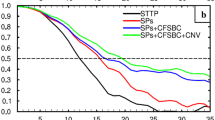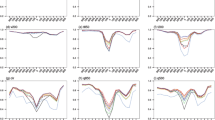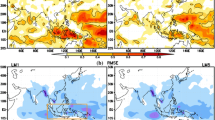Abstract
The Madden–Julian Oscillation (MJO) is the primary mode of tropical intraseasonal climate variability and has significant modulation of global climate variations and attendant societal impacts. Advancing prediction of the MJO using state of the art observational data and modeling systems is thus a necessary goal for improving global intraseasonal climate prediction. MJO prediction is assessed in the NOAA Climate Forecast System version 2 (CFSv2) based on its hindcasts initialized daily for 1999–2010. The analysis focuses on MJO indices taken as the principal components of the two leading EOFs of combined 15°S–15°N average of 200-hPa zonal wind, 850-hPa zonal wind and outgoing longwave radiation at the top of the atmosphere. The CFSv2 has useful MJO prediction skill out to 20 days at which the bivariate anomaly correlation coefficient (ACC) drops to 0.5 and root-mean-square error (RMSE) increases to the level of the prediction with climatology. The prediction skill also shows a seasonal variation with the lowest ACC during the boreal summer and highest ACC during boreal winter. The prediction skills are evaluated according to the target as well as initial phases. Within the lead time of 10 days the ACC is generally greater than 0.8 and RMSE is less than 1 for all initial and target phases. At longer lead time, the model shows lower skills for predicting enhanced convection over the Maritime Continent and from the eastern Pacific to western Indian Ocean. The prediction skills are relatively higher for target phases when enhanced convection is in the central Indian Ocean and the central Pacific. While the MJO prediction skills are improved in CFSv2 compared to its previous version, systematic errors still exist in the CFSv2 in the maintenance and propagation of the MJO including (1) the MJO amplitude in the CFSv2 drops dramatically at the beginning of the prediction and remains weaker than the observed during the target period and (2) the propagation in the CFSv2 is too slow. Reducing these errors will be necessary for further improvement of the MJO prediction.










Similar content being viewed by others
References
Bessafi M, Wheeler MC (2006) Modulation of south Indian Ocean tropical cyclones by the Madden–Julian Oscillation and convectively coupled equatorial waves. Mon Weather Rev 134:638–656
Chelliah M, Ebisuzaki W, Weaver S, Kumar A (2011) Evaluating the tropospheric variability in NCEP’s Climate Forecast System reanalysis. J Geophys Res Atmos 116:D17107. doi:10.1029/2011JD015707
Fu X, Wang B, Lee J-Y, Wang W, Gao L (2011) Sensitivity of dynamical intraseasonal prediction skills to different initial conditions. Mon Weather Rev 139:2572–2592
Fu X, Lee J-Y, Hsu P-C, Taniguchi H, Wang B, Wang W, Weaver S (2013) Multi-model MJO forecasting during DYNAMO/CINDY period. Clim Dyn (submitted)
Higgins RW, Schemm JKE, Shi W, Leetmaa A (2000) Extreme precipitation events in the western United States related to tropical forcing. J Clim 13:793–820
Hung M-P, Lin J-L, Wang W, Kim D, Shinoda T, Weaver SJ (2013) MJO and convectively coupled equatorial waves simulated by CMIP5 climate models. J Clim (accepted)
Inness PM, Slingo JM (2006) The interaction of the Madden–Julian oscillation with the maritime continent in a GCM. Q J R Meteorol Soc 132:1645–1667
Janowiak JE, Bauer P, Wang W, Arkin PA, Gottschalck J (2010) An evaluation of precipitation forecasts from operational models and reanalyses including precipitation variations associated with MJO activity. Mon Weather Rev 138:4542–4560. doi:10.1175/2010MWR3436.1
Jiang X, Waliser DE, Wheeler MC, Jones C, Lee MN, Schuert SD (2008) Assessing the skill of an all-season statistical forecast model for the Madden-Julian oscillation. Mon Weather Rev 136:1940–1956. doi:10.1175/2007MWR2305.1
Jones C, Schemm J-KE (2000) The influence of intraseasonal variations on medium-range weather forecasts over South America. Mon Weather Rev 128:486–494
Jones C, Waliser DE, Lau KM, Stern W (2004) The Madden-Julian oscillation and its impact on Northern Hemisphere weather predictability. Mon Weather Rev 132:1462–1471
Kalnay E, Kanamitsu M, Kistler R, Collins W, Deaven D, Gandin L, Iredell M, Higgins W, Janowiak J, Mo KC, Ropelewski C, Wang J, Leetma A, Reynolds R, Jenne R, Joseph D (1996) The NCEP/NCAR 40-year reanalysis project. Bull Am Meteorol Soc 77:437–471
Kanamitsu M, Ebisuzaki W, Woollen J, Yang S-K, Hnilo JJ, Fiorino M, Potter GL (2002) NCEP–DOE AMIP-II reanalysis (R-2). Bull Am Meteorol Soc 83:1631–1643
Kaylor RE (1977) Filtering and decimation of digital time series. Institute of Physical Science Technology Tech. Note BN 850, University of Maryland, College park
Kessler WS, Kleeman R (2000) Rectification of the Madden-Julian oscillation into the ENSO cycle. J Clim 13:3560–3575
Kumar A (2009) Finite samples and uncertainty estimates for skill measures for seasonal predictions. Mon Weather Rev 137:2622–2631
L’Heureux ML, Higgins RW (2008) Boreal winter links between the Madden-Julian oscillation and the Arctic oscillation. J Clim 21:3040–3050
Lau KM, Peng L (1987) Origin of low frequency (intraseasonal) oscillations in the tropical atmosphere. Part I: the basic theory. J Atmos Sci 44:950–972
Liebmann B, Smith CA (1996) Description of a complete (interpolated) outgoing longwave radiation dataset. Bull Am Meteorol Soc 77:1275–1277
Lin H, Brunet G (2009) The influence of the Madden–Julian oscillation on Canadian wintertime surface air temperature. Mon Weather Rev 137:2250–2262
Lin JL, Kiladis GN, Mapes BE, Weickmann KM, Sperber KR, Lin W, Wheeler MC, Schubert SD, et al (2006) Tropical intraseasonal variability in 14 IPCC AR4 climate models. Part I: convective signals. J Clim 19:2665–2690
Lin H, Brunet G, Derome J (2008) Forecast skill of the Madden–Julian oscillation in two Canadian atmospheric models. Mon Weather Rev 136:4130–4149
Lin H, Brunet G, Derome J (2009) An observed connection between the North Atlantic oscillation and the Madden-Julian oscillation. J Clim 22:364–380
Madden RA, Julian PR (1971) Detection of a 40–50 day oscillation in the zonal wind in the tropical Pacific. J Atmos Sci 28:702–708
Madden RA, Julian PR (1972) Description of global-scale circulation cells in the tropics with a 40–50 day period. J Atmos Sci 29:1109–1123
Maloney ED, Hartmann DL (2000a) Modulation of eastern North Pacific hurricanes by the Madden-Julian Oscillation. J Clim 11:2387–2403
Maloney ED, Hartmann DL (2000b) Modulation of hurricane activity in the Gulf of Mexico by the Madden-Julian oscillation. Science 287:2002–2004
Matsueda M, Endo H (2011) Verification of medium-range MJO forecasts with TIGGE. Geophys Res Lett 38, L11801. doi:10.1029/2011GL047480
National Research Council (2010) Assessment of intraseasonal to interannual climate prediction and predictability. The National Academies Press, Washington, DC
Rashid HA, Hendon HH, Wheeler MC, Alves O (2010) Prediction of the Madden-Julian oscillation with the POAMA dynamical prediction system. Clim Dyn. doi:10.1007/s00382-010-0754-x
Reichler T, Roads J (2005) Long-range predictability in the tropics. Part II: 30–60 day variability. J Clim 18:634–649
Saha S, et al (2013) The NCEP Climate Forecast System version 2. J Clim (submitted)
Saha S et al (2006) The NCEP Climate Forecast System. J Clim 19:3483–3517
Saha S et al (2010) The NCEP Climate Forecast System reanalysis. Bull Am Met Soc 91:1015–1057
Seo K-H, Wang W (2010) The Madden–Julian oscillation simulated in the NCEP Climate Forecast System model: the importance of stratiform heating. J Clim 23:4770–4793. doi:10.1175/2010JCLI2983.1
Seo K-H, Wang W, Gottschalck J, Zhang Q, Schemm J-KE, Higgins WR, Kumar A (2009) Evaluation of MJO forecast skill from several statistical and dynamical forecast models. J Clim 22:2372–2388
Van den Dool H, Toth Z (1991) On the weights for an ensemble-averaged 6–10-day forecast. Weather Forecast 9:457–465
Vitart F, Woolnough S, Balmaseda MA, Tompkins AM (2007) Monthly forecast of the Madden-Julian Oscillation using a coupled GCM. Mon Weather Rev 135:2700–2715
Vitart F, Buizza R, Balmaseda MA, Balsamo G, Bidlot J-R, Bonet A, Fuentes M, Hofstadler A, Molteni F, Palmer TN (2008) The new VarEPS-monthly forecasting system: a first step towards seamless prediction. Q J R Meteorol Soc 134:1789–1799
Vitart F, Leroy A, Wheeler MC (2010) A comparison of dynamical and statistical predictions of weekly tropical cyclone activity in the southern hemisphere. Mon Weather Rev 138:3671–3682. doi:10.1175/2010mwr3343.1
Waliser DE, Lau KM, Stern W, Jones C (2003) Potential predictability of the Madden-Julian oscillation. Bull Am Meteorol Soc 84:33–50
Wang W, Chen M, Kumar A (2009) Impacts of ocean surface on the northward propagation of the boreal summer intraseasonal oscillation in the NCEP climate forecast system. J Clim 22:6561–6576
Wang W, Chen M, Kumar A, Xue Y (2011) How important is intraseasonal surface wind variability to real-time ENSO prediction? Geophys Res Lett 38:L13705. doi:10.1029/2011GL047684
Wang J, Wang W, Fu X, Seo K-H (2012) Tropical intraseasonal rainfall variability in the CFSR. Clim Dyn 38:2191–2207. doi:10.1007/s00382-011-1087-0
Weaver SJ, Wang W, Chen M, Kumar A (2011) Representation of MJO variability in the NCEP Climate Forecast System. J Clim 24:4676–4694
Wheeler MC, Hendon HH (2004) An all-season real-time multivariate MJO index: development of an index for monitoring and prediction. Mon Weather Rev 132:1917–1932
Zhang Q, van den Dool H (2012) Relative merit of model improvement versus availability of retrospective forecasts: the case of Climate Forecast System MJO prediction. Weather Forecast 27:1045–1051
Zhou S, Miller AJ (2005) The interaction of the Madden–Julian oscillation and the Arctic Oscillation. J Clim 18:143–159
Author information
Authors and Affiliations
Corresponding author
Additional information
This paper is a contribution to the Topical Collection on Climate Forecast System Version 2 (CFSv2). CFSv2 is a coupled global climate model and was implemented by National Centers for Environmental Prediction (NCEP) in seasonal forecasting operations in March 2011. This Topical Collection is coordinated by Jin Huang, Arun Kumar, Jim Kinter and Annarita Mariotti.
Rights and permissions
About this article
Cite this article
Wang, W., Hung, MP., Weaver, S.J. et al. MJO prediction in the NCEP Climate Forecast System version 2. Clim Dyn 42, 2509–2520 (2014). https://doi.org/10.1007/s00382-013-1806-9
Received:
Accepted:
Published:
Issue Date:
DOI: https://doi.org/10.1007/s00382-013-1806-9




